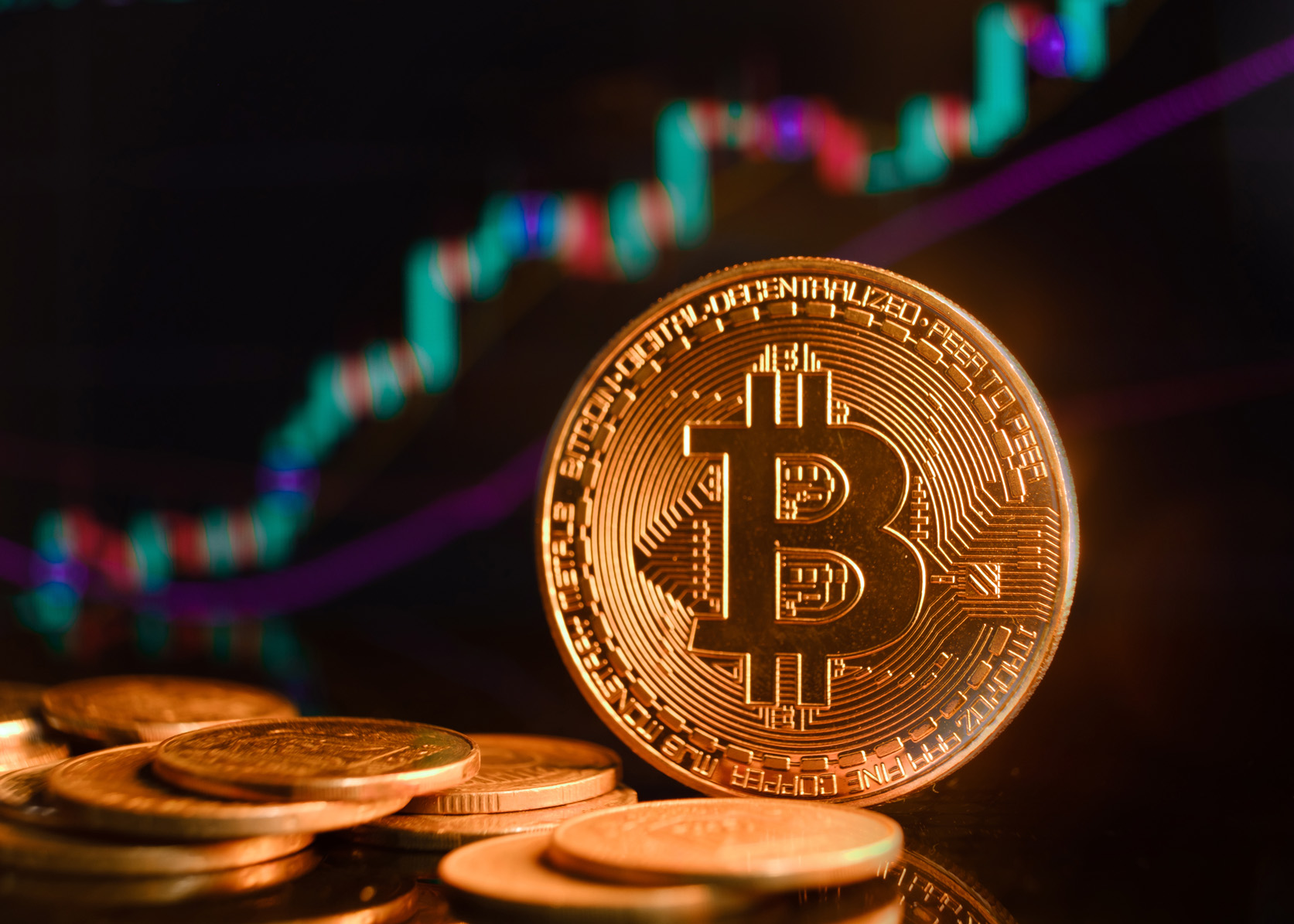 The election of Donald Trump saw the market price of bitcoin rise from $67 839 on election day (5 November 2024) to £106 168 on 18 December: a rise of 56%. It was $104 441 the day before inauguration (20 January 2025).
The election of Donald Trump saw the market price of bitcoin rise from $67 839 on election day (5 November 2024) to £106 168 on 18 December: a rise of 56%. It was $104 441 the day before inauguration (20 January 2025).
Trump has been a keen supporter of cryptocurrencies. He has stated that he wants the USA to become the world’s ‘crypto capital’. Indeed, he and Melania Trump have launched their own meme coins hosted on the Solana blockchain. Meme coins are tokens, a form of cryptocurrency, inspired by specific individuals, characters, cartoons or artwork.
On 23 January, three days after his inauguration, President Trump signed an Executive Order. This states that it is:
…the policy of my Administration to support the responsible growth and use of digital assets, blockchain technology, and related technologies across all sectors of the economy, including by … protecting and promoting the ability of individual citizens and private-sector entities alike to access and use for lawful purposes open public blockchain networks without persecution, including the ability to develop and deploy software, to participate in mining and validating, to transact with other persons without unlawful censorship, and to maintain self-custody of digital assets…
The full Executive Order can be read here.
Cryptocurrencies
Although cryptocurrencies can be used for certain transactions and avoid the need for banks, their use as a medium of exchange or unit of account is limited by their price volatility. The supply of national or regional currencies, such as the US dollar, the euro and the pound sterling is controlled by central banks, and central banks have a key mandate of achieving price stability, where price is in terms of their currency’s consumer price index. Although exchange rates fluctuate and thereby affect the prices of internationally traded goods and assets, such fluctuations are small in comparison with crypto price fluctuations.
 The supply of many cryptocurrencies is not controlled with the objective of achieving price stability. Indeed, certain cryptocurrencies, such as bitcoin (the coins with the highest total market value of approximately $2060bn) have a limited maximum supply. The supply of bitcoin in January 2025 is officially 19.81m, 94.3% of the eventual official total of 21m. However, with some 1.8m coins lost, the current effective total supply is more like 18m and the ceiling 19.2m. New coins are created by ‘mining’, involving massive computer power to perform complex calculations. Coins in circulation at any one time are therefore fixed and increase only slowly and at a decelerating rate over time, with increased mining costs per coin. On any one day, however, the supply offered for sale can fluctuate wildly.
The supply of many cryptocurrencies is not controlled with the objective of achieving price stability. Indeed, certain cryptocurrencies, such as bitcoin (the coins with the highest total market value of approximately $2060bn) have a limited maximum supply. The supply of bitcoin in January 2025 is officially 19.81m, 94.3% of the eventual official total of 21m. However, with some 1.8m coins lost, the current effective total supply is more like 18m and the ceiling 19.2m. New coins are created by ‘mining’, involving massive computer power to perform complex calculations. Coins in circulation at any one time are therefore fixed and increase only slowly and at a decelerating rate over time, with increased mining costs per coin. On any one day, however, the supply offered for sale can fluctuate wildly.
Some other crypto currencies also have a long-term supply ceiling and are created by mining. Others, such as ether (the coins with the second highest market value of approximately $394bn) do not have a fixed supply ceiling. They are not created by mining, but by a system known as ‘Proof-of-Stake (PoS)’. This uses the cryptocurrency’s owners, who stake some of their currency, to validate transactions on the Ethereum blockchain. They receive new ether as a reward. PoS uses considerably less energy than mining and hence is regarded as greener.
Unlike mined coins, Ethereum coins (ether) created by PoS can be ‘burned’: i.e. removed from circulating supply. This can more than offset new coins created and lead to a net decrease in supply. See the Fidelity Digital Assets and Paxful links below for a discussion of what determines the net burn/net creation rate of ether. Other coins, such as BNB (Binance’s cryptocurrency), have regular burns to control supply.
 There are some cryptocurrencies that are suitable as a medium of exchange and as a unit of value. These are ‘stablecoins’, whose value is linked 1:1 to a major currency, such as the US dollar or euro. Supply is adjusted to maintain this value. Stablecoins are used primarily for transactions. They account for some two-thirds of all transactions using crypto. They are particularly used for transactions in parts of the world with monetary instability and/or limited access to major currencies.
There are some cryptocurrencies that are suitable as a medium of exchange and as a unit of value. These are ‘stablecoins’, whose value is linked 1:1 to a major currency, such as the US dollar or euro. Supply is adjusted to maintain this value. Stablecoins are used primarily for transactions. They account for some two-thirds of all transactions using crypto. They are particularly used for transactions in parts of the world with monetary instability and/or limited access to major currencies.
With the exception of stablecoins, crypto currencies are best seen as assets, rather than as a means of exchange or unit of account. As such, they are more comparable to gold than to conventional currencies.
The market for crypto in the long term
The market price of cryptocurrencies is determined by supply and demand. With limited supply, their price is likely to increase as demand is forecast to increase relative to supply. This is particularly the case with mined cryptocurrencies where there is a ceiling to supply. But even with PoS-created currencies, the amount supplied is likely to increase more slowly than demand, especially with burn mechanisms in place.
With many countries recognising and embracing cryptocurrencies as an asset, so the long-term price should rise. The endorsement by Donald Trump is likely to hasten this process.
The market for crypto in the short term
While the total supply of cryptocurrency is limited, the supply to market can fluctuate wildly, as can demand. This can cause huge gyrations in price.
Short-run demand and supply decisions are governed largely by expectations of future price changes, over anything from the next few hours to the coming months. If people think the price will rise, people will demand more, while those already holding crypto and thinking of selling will hold back. These actions will amplify the very effect they had predicted, namely a rise in price.
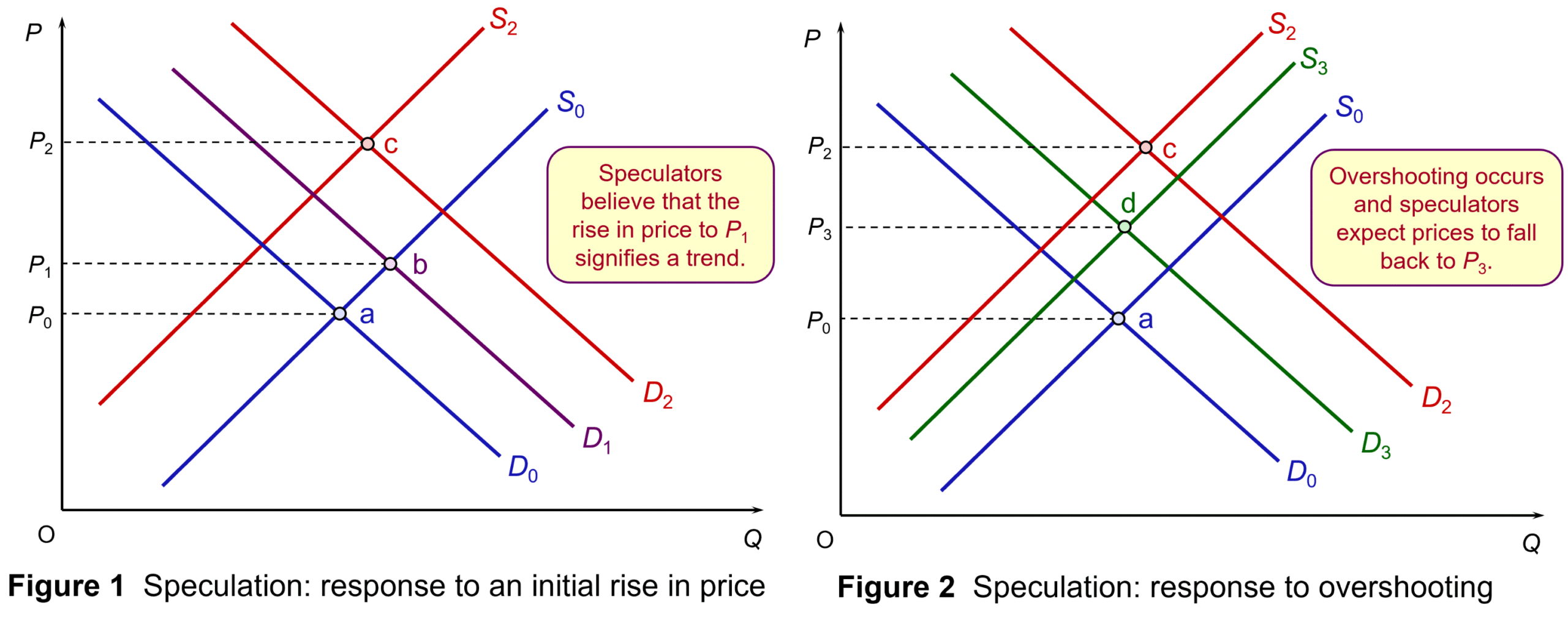
This is illustrated in Figure 1. Assume an initial rise in demand for a particular cryptocurrency from D0 to D1. Equilibrium moves from point a to point b and the price of the cryptocurrency rises from P0 to P1. Speculators believe that this is a trend and that prices will rise further. Demand increases to D2 as purchasers rush to buy; and supply falls to S2 as potential sellers of the crypto hold back. Equilibrium moves to point c and price rises to P2.
But in their exuberance, people may have pushed the price above the level that reflects underlying demand and supply. People respond to this overshooting by selling some of the currency to take advantage of what they see as a temporary high price. In Figure 2, supply rises from S2 to S3. Meanwhile, potential purchasers wait until price has settled back somewhat. Demand falls from D2 to D3. Equilibrium moves to point d, with price falling to P3. (Click here for a PowerPoint of the two diagrams.)

A similar process of speculation takes place when people expect prices to fall, with price potentially plummeting before it then recovers somewhat.
With computer algorithms interpreting underlying economic/political data, the price changes are likely to be frequent, with speculation amplifying these changes.
Articles
- Trump orders crypto working group to draft new regulations, explore national stockpile
Reuters, Hannah Lang and Trevor Hunnicutt (24/1/25)
- Bitcoin soars past $109,000 ahead of possible early action on crypto by Trump
MSN, Alan Suderman (20/1/25)
- 3 Things to Watch as Trump Becomes Memecoin Billionaire and US President
PYMNTS (20/1/25)
- Crypto Community Reacts to Trump and Melania Meme Coins as Market Sinks
Decrypt, Vismaya V (20/1/25)
- Trump’s plan for a strategic bitcoin reserve could trigger a crypto ‘arms race’ and reshape the global economic order
The Conversation, Huw Macartney, Erin McCracken and Robert Elliott (14/1/25)
- Bitcoin’s resurgence: A regulatory reset and a path to innovation
crypto.news, editorial (17/1/25)
- Bitcoin Retreats As Traders Await Trump Crypto Executive Order
Bloomberg on NDTV Profit (21/1/25)
- Bitcoin edges higher as investors shake off initial Trump Day One disappointment
Reuters, Tom Westbrook and Elizabeth Howcroft (21/1/25)
- Has bitcoin’s limited supply driven its rally? Experts weigh in
ABC News, Max Zahn (10/12/24)
Background information
Data
Questions
- What determines the supply of cryptocurrencies (a) in circulation; (b) to the market at any given time?
- Why are the prices of digital currencies so volatile?
- Why or why not are cryptocurrencies a good asset to hold?
- How may speculation (a) amplify and (b) dampen price fluctuations?
- What determines the net burn/net creation rate of ether?
- Should cryptocurrencies be classified as ‘money’?
 People are beginning to get used to low oil prices and acting as if they are going to remain low. Oil is trading at only a little over $30 per barrel and Saudi Arabia is unwilling to backtrack on its policy of maintaining its level of production and not seeking to prevent oil prices from falling. Currently, there is still a position of over supply and hence in the short term the price could continue falling – perhaps to $20 per barrel.
People are beginning to get used to low oil prices and acting as if they are going to remain low. Oil is trading at only a little over $30 per barrel and Saudi Arabia is unwilling to backtrack on its policy of maintaining its level of production and not seeking to prevent oil prices from falling. Currently, there is still a position of over supply and hence in the short term the price could continue falling – perhaps to $20 per barrel.
But what of the future? What will happen in the medium term (6 to 12 months) and the longer term? Investment in new oil wells, both conventional and shale oil, have declined substantially. The position of over supply could rapidly come to an end. The Telegraph article below quotes the International Energy Agency’s executive director, Fatih Birol, as saying:
“Investment in oil exploration and production across the world has been cut to the bone, falling 24% last year and an estimated 17% this year. This is… far below the minimum levels needed to keep up with future demand. …
It is easy for consumers to be lulled into complacency by ample stocks and low prices today, but they should heed the writing on the wall: the historic investment cuts raise the odds of unpleasant oil security surprises in the not too distant future.”
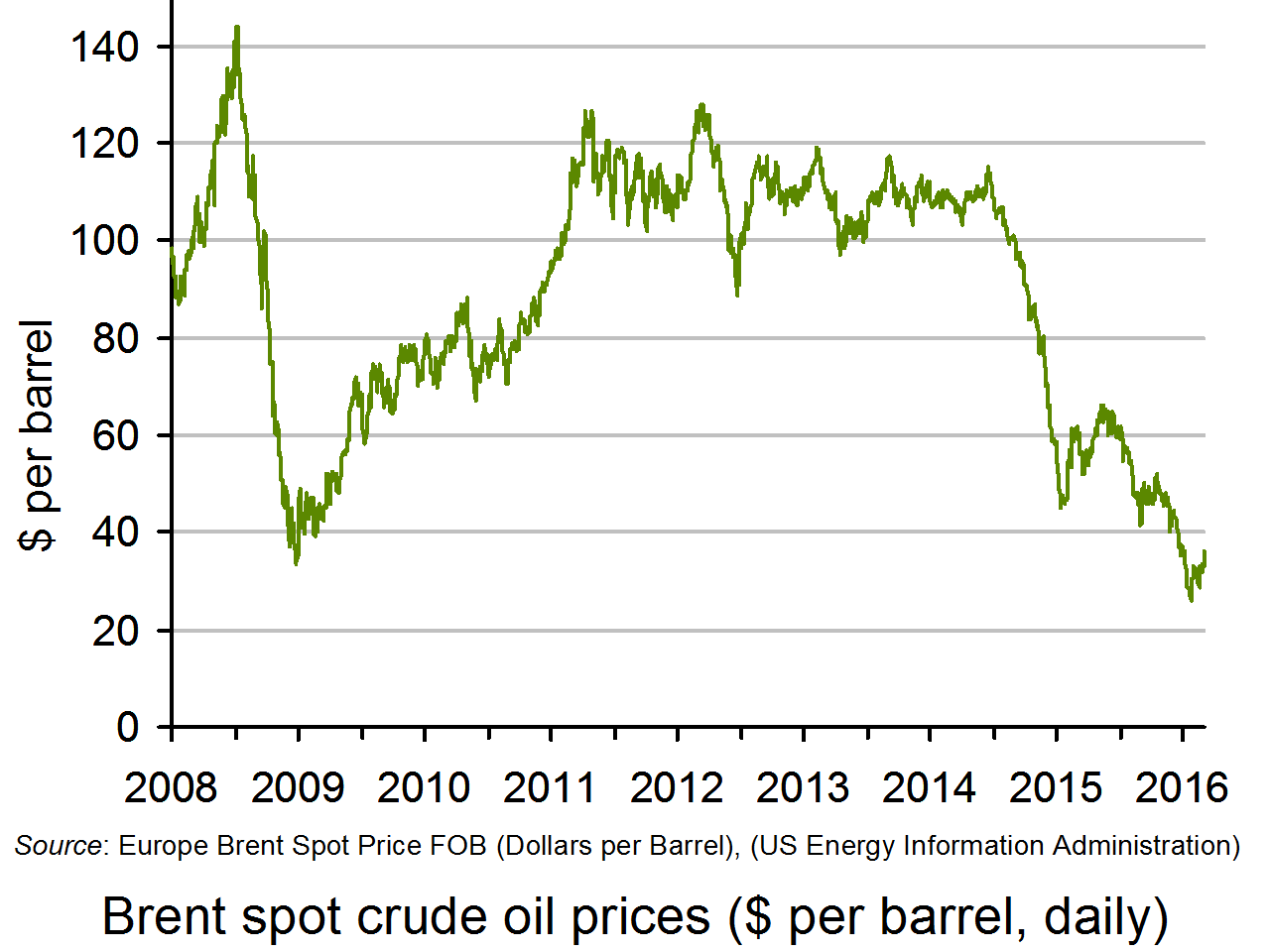 And in the Overview of the IEA’s 2016 Medium-Term Oil Market Report, it is stated that
And in the Overview of the IEA’s 2016 Medium-Term Oil Market Report, it is stated that
In today’s oil market there is hardly any spare production capacity other than in Saudi Arabia and Iran and significant investment is required just to maintain existing production before we move on to provide the new capacity needed to meet rising oil demand. The risk of a sharp oil price rise towards the later part of our forecast arising from insufficient investment is as potentially de-stabilising as the sharp oil price fall has proved to be.
The higher-cost conventional producers, such as Venezuela, Nigeria, Angola, Russia and off-shore producers, could take a long time to rebuild capacity as investment in conventional wells is costly, especially off-shore.
As far as shale oil producers is concerned – the prime target of Saudi Arabia’s policy of not cutting back supply – production could well bounce back after a relatively short time as wells are re-opened and investment in new wells is resumed.
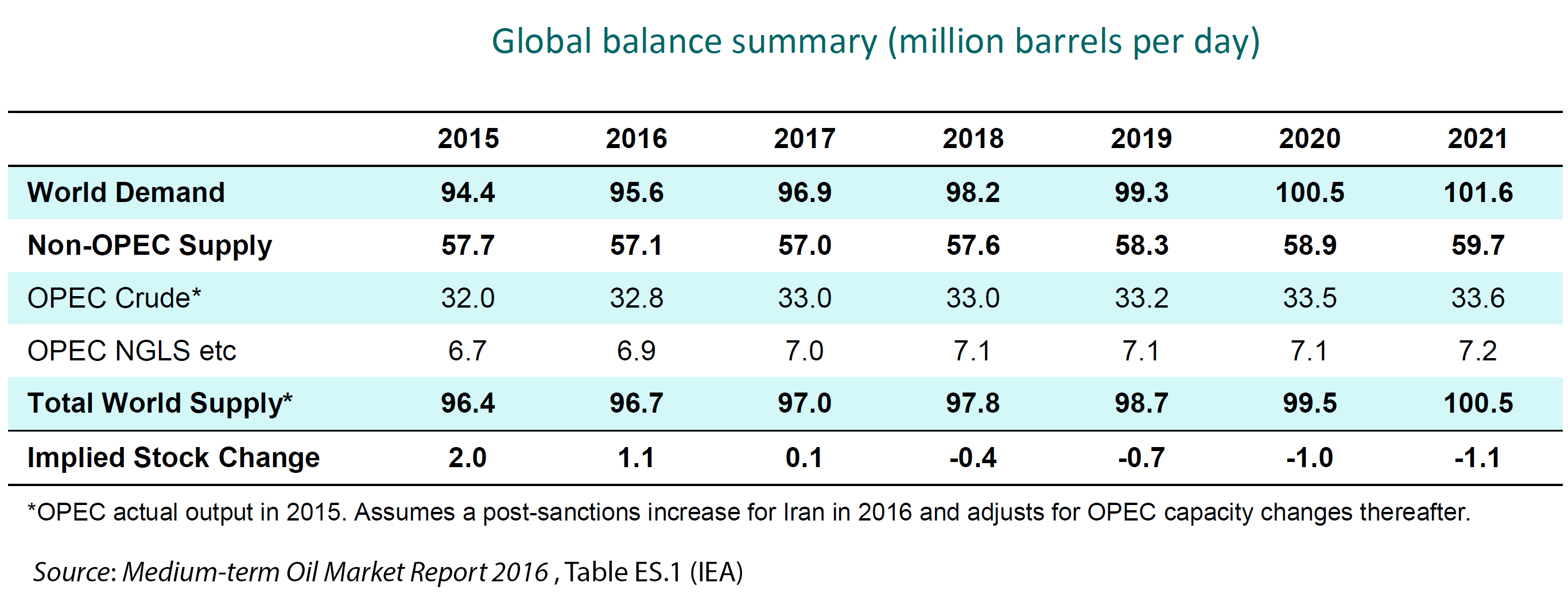
But, price rises in the medium term could then be followed by lower prices again a year or two thereafter as oil from new investment comes on stream: or they could continue rising if investment is insufficient. It depends on the overall balance of demand and supply. The table shows the IEA’s forecast of production and consumption and the effect on oil stocks. From 2018, it is predicting that consumption will exceed production and that, therefore, stocks will fall – and at an accelerating rate.
But just what happens to the balance of production and consumption will also depend on expectations. If shale oil investors believe that an oil price bounce is temporary, they are likely to hold off investing. But this will, in turn, help to sustain a price bounce, which in turn, could help to encourage investment. So expectations of investors will depend on what other investors expect to happen – a very difficult outcome to predict. It’s a form of Keynesian beauty contest (see the blog post A stock market beauty contest of the machines) where what is important is what other people think will happen, which in turn depends on what they think other people will do, and so on.
Webcast
 At $30 oil price, shale rebound may take much, much longer CNBC, Patti Domm , Bob Iaccino, Helima Croft and Matt Smith (25/2/16)
At $30 oil price, shale rebound may take much, much longer CNBC, Patti Domm , Bob Iaccino, Helima Croft and Matt Smith (25/2/16)
Article
Opec has failed to stop US shale revolution admits energy watchdog The Telegraph, Ambrose Evans-Pritchard (27/2/16)
Report
Medium-term Oil Market Report 2016: Overview International Energy Agency (IEA) (22/2/16)
Questions
- Using demand and supply diagrams, demonstrate (a) what happened to oil prices in 2015; (b) what is likely to happen to them in 2016; (c) what is likely to happen to them in 2017/18.
- Why have oil prices fallen so much over the past 12 months?
- Using aggregate demand and supply analysis, demonstrate the effect of lower oil prices on a national economy.
- What have have been the advantages and disadvantages of lower oil prices? In your answer, distinguish between the effects on different people, countries and the world generally.
- Why is oil supply more price elastic in the long run than in the short run?
- Why does supply elasticity vary between different types of oil fields (a) in the short run; (b) in the long run?
- What determines whether speculation about future oil prices is likely to be stabilising or destabilising?
- What role has OPEC played in determining the oil price over the past few months? What role can it play over the coming years?
- Explain the concept of a ‘Keynesian beauty contest’ in the context of speculation about future oil prices, and why this makes the prediction of future oil prices more difficult.
- Give some other examples of human behaviour which is in the form of a Keynesian beauty contest.
- Why may playing a Keynesian beauty contest lead to an undesirable Nash equilibrium?
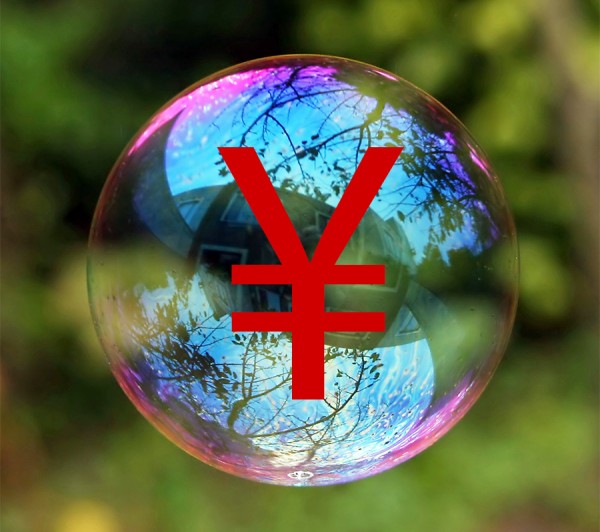 Many Chinese people have taken to investing on the Chinese stock market, seeing it as a way of making a lot of money quickly. From October 2014 to June this year the market soared, rising by 126% from 2290 to 5166.
Many Chinese people have taken to investing on the Chinese stock market, seeing it as a way of making a lot of money quickly. From October 2014 to June this year the market soared, rising by 126% from 2290 to 5166.
More and more people used their savings to buy stocks and China now has over 90 million individual investors. And it was not just savings that were invested. Increasingly people have been borrowing money to invest, seeing it as an easy way of making money. Unlike stock markets in developed countries, where the majority of shares are held by financial organisations, such as pension funds, holdings by individuals account for about 80% of stocks on the Chinese market.
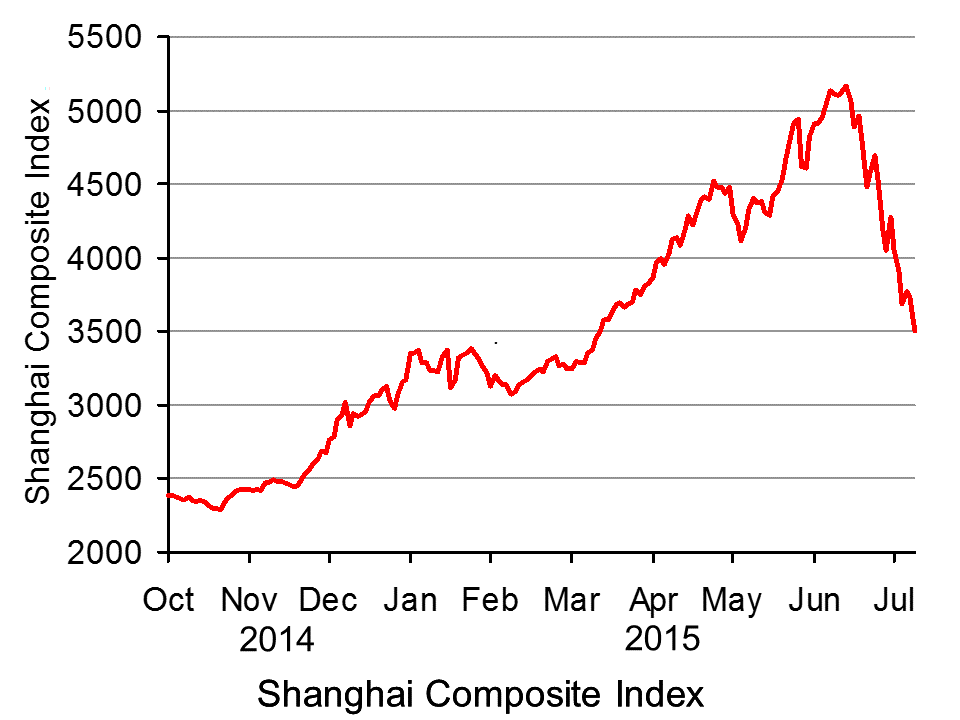 But since mid-June, share prices have plummeted by 32% (see chart). People have thus seen a huge fall in the value of their savings, while many others have found their shareholdings worth less than their debts. The fall, like the rise that preceded it, has been driven by speculation, fuelled by first optimism and then pessimism.
But since mid-June, share prices have plummeted by 32% (see chart). People have thus seen a huge fall in the value of their savings, while many others have found their shareholdings worth less than their debts. The fall, like the rise that preceded it, has been driven by speculation, fuelled by first optimism and then pessimism.
The Chinese government is worried that the fall might dampen investment and economic growth. It has thus has been supplying liquidity to various institutions to buy shares, but this has had little effect and is dismissed by many as meddling. What is more it could expose companies which take advantage of the liquidity to greater risk.
So serious has been the rout, that over 50% of listed companies have halted trading on the mainland Chinese stock exchanges.
So just why has there been this bubble and why has it burst? What implications will it have for (a) China and (b) the rest of the world? The following articles explore the issues.

China’s stock market fall hits small investors BBC News Magazine, John Sudworth (7/7/15)
 China Stocks Plunge as State Support Fails to Revive Confidence Bloomberg (8/7/15)
China Stocks Plunge as State Support Fails to Revive Confidence Bloomberg (8/7/15)
Chinese stocks are crashing Business Insider UK, Myles Udland, David Scutt (8/7/15)
Shanghai stocks plunge, over 1,200 Chinese companies halt trading Economic Times of India (8/7/15)
Everyone freaking out about China’s stock-market crash is missing one thing Business Insider UK, Elena Holodny (7/7/15)
China’s stock market has lost nearly a third of its value in a month Vox, Timothy B. Lee (8/7/15)
Chinese leaders may be undermined as investors suffer stock market slide The Guardian, Emma Graham-Harrison (8/7/15)
Opinion: China’s stock-market crash is just beginning MarketWatch, Howard Gold (8/7/15)
What does China’s stock market crash tell us? BBC News (22/7/15)
Questions
- What is meant by a ‘bubble’? Has the recent performance of the Shanghai Stock Market been an example of a bubble?
- Is the current fall in share prices in China an example of overshooting? Explain how you would decide.
- Distinguish between stabilising and destabilising speculation. Why does destabilising speculation not go on for ever?
- What is meant by the ‘stock market wealth effect’? How is the fall in the Chinese stock market likely to affect consumption and investment in China? How does the proportion of assets held in the form of shares affect the magnitude of the effect?
- What are the likely implications of the fall in the Chinese stock market for the rest of the world?
- Why has the Hong Kong stock market not behaved in the same way as the Shanghai market?
- What have the Chinese authorities been doing to arrest the fall in share prices? How likely are they to succeed?
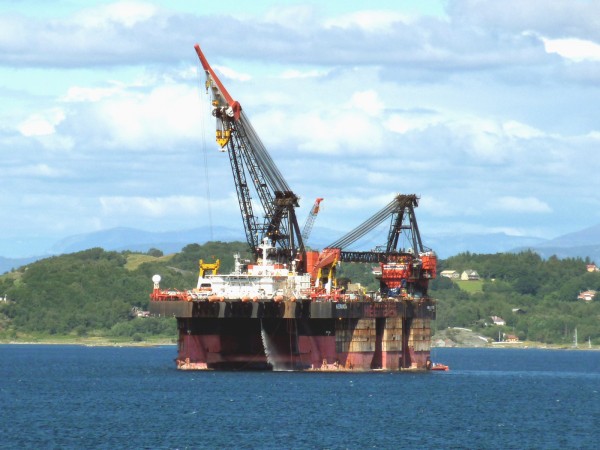 The recent low price of oil has been partly the result of faltering global demand but mainly the result of increased supply from shale oil deposits. The increased supply of shale oil has not been offset by a reduction in OPEC production. Quite the opposite: OPEC has declared that it will not cut back production even if the price of oil were to fall to $30 per barrel.
The recent low price of oil has been partly the result of faltering global demand but mainly the result of increased supply from shale oil deposits. The increased supply of shale oil has not been offset by a reduction in OPEC production. Quite the opposite: OPEC has declared that it will not cut back production even if the price of oil were to fall to $30 per barrel.
We looked at the implications for the global economy in the post, A crude indicator of the economy (Part 2). We also looked at the likely effect on oil prices over the longer term and considered what the long-run supply curve might look like. Here we examine the long-run effect on prices in more detail. In particular, we look at the arguments of two well-known commentators, Jim O’Neill and Anatole Kaletsky, both of whom have articles on the Project Syndicate site. They disagree about what will happen to oil prices and to energy markets more generally in 2015 and beyond.
Jim O’Neill argues that with shale oil production becoming unprofitable at the low prices of late 2014/early 2015, the oil price will rise. He argues that a good indicator of the long-term equilibrium price of oil is the five-year forward price, which is much less subject to speculation and is more reflective of the fundamentals of demand and supply. The five-year forward price is around $80 per barrel – a level to which O’Neill thinks oil prices are heading.
 Anatole Kaletsky disagrees. He sees $50 per barrel as a more likely long-term equilibrium price. He argues that new sources of oil have made the oil market much more competitive. The OPEC cartel no longer has the market power it had from the mid 1970s to the mid 1980s and from the mid 2000s, when surging Chinese demand temporarily created a global oil shortage and strengthened OPEC’s control of prices. Instead, the current situation is more like the period from 1986 to 2004 when North Sea and Alaskan oil development undermined OPEC’s power and made the oil market much more competitive.
Anatole Kaletsky disagrees. He sees $50 per barrel as a more likely long-term equilibrium price. He argues that new sources of oil have made the oil market much more competitive. The OPEC cartel no longer has the market power it had from the mid 1970s to the mid 1980s and from the mid 2000s, when surging Chinese demand temporarily created a global oil shortage and strengthened OPEC’s control of prices. Instead, the current situation is more like the period from 1986 to 2004 when North Sea and Alaskan oil development undermined OPEC’s power and made the oil market much more competitive.
Kaletsky argues that in a competitive market, price will equal the marginal cost of the highest cost producer necessary to balance demand and supply. The highest cost producers in this case are the shale oil producers in the USA. As he says:
Under this competitive logic, the marginal cost of US shale oil would become a ceiling for global oil prices, whereas the costs of relatively remote and marginal conventional oilfields in OPEC and Russia would set a floor. As it happens, estimates of shale-oil production costs are mostly around $50, while marginal conventional oilfields generally break even at around $20. Thus, the trading range in the brave new world of competitive oil should be roughly $20 to $50.
So who is right? Well, we will know in twelve months or more! But, in the meantime, try to use economic analysis to judge the arguments by answering the questions below.
The Price of Oil in 2015 Project Syndicate, Jim O’Neill (7/1/15)
A New Ceiling for Oil Prices Project Syndicate, Anatole Kaletsky (14/1/15)
Questions
- For what reasons might the five-year forward price of oil be (a) a good indicator and (b) a poor indicator of the long-term price of oil?
- Under O’Neill’s analysis, what would the long-term supply curve of oil look like?
- Are shale oil producers price takers? Explain.
- Draw a diagram showing the marginal and average cost curves of a swing shale oil producer. Put values on the vertical axis to demonstrate Kaletsky’s arguments. Also put average and marginal revenue on the diagram and show the amount of profit at the maximum-profit point.
- Why are shale oil producers likely to have much higher long-run average costs than short-run variable costs? How does this affect Kaletsky’s arguments?
- Under Kaletsky’s analysis, what would the long-term supply curve of oil look like?
- Criticise Kaletsky’s arguments from O’Neill’s point of view.
- Criticise O’Neill’s arguments from Kaletsky’s point of view.
- Will OPEC’s policy of not cutting back production help to restore its position of market power?
- Why might the fall in the oil price below $50 in early 2015 represent ‘overshooting’? Why does overshooting often occur in volatile markets?
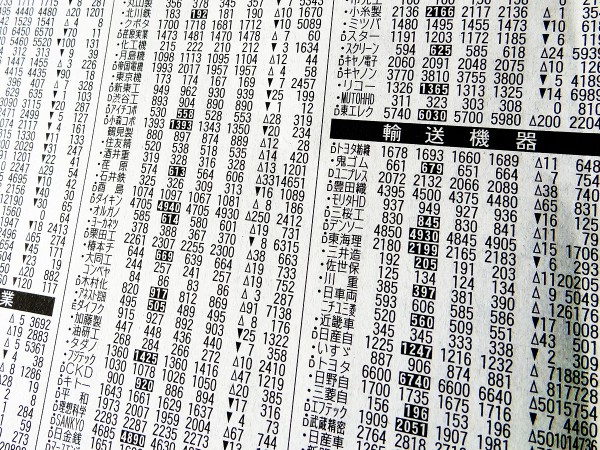 Each day many investors anxiously watch the stock market to see if their shares have gone up or down. They may also speculate: buying if they think share prices are likely to go up; selling if they think their shares will fall. But what drives these expectations?
Each day many investors anxiously watch the stock market to see if their shares have gone up or down. They may also speculate: buying if they think share prices are likely to go up; selling if they think their shares will fall. But what drives these expectations?
To some extent, people will look at real factors, such as company sales and profits or macroeconomic indicators, such as the rate of economic growth or changes in public-sector borrowing. But to a large extent people are trying to predict what other people will do: how other people will react to changes in various indicators.
 John Maynard Keynes observed this phenomenon in Chapter 12 of his General Theory of Employment, Interest and Money of 1936. He likened this process of anticipating what other people will do to a newspaper beauty contest, popular at the time. In fact, behaviour of this kind has become known as a Keynesian beauty contest (see also).
John Maynard Keynes observed this phenomenon in Chapter 12 of his General Theory of Employment, Interest and Money of 1936. He likened this process of anticipating what other people will do to a newspaper beauty contest, popular at the time. In fact, behaviour of this kind has become known as a Keynesian beauty contest (see also).
Keynes wrote that:
professional investment may be likened to those newspaper competitions in which the competitors have to pick out the six prettiest faces from a hundred photographs, the prize being awarded to the competitor whose choice most nearly corresponds to the average preferences of the competitors as a whole; so that each competitor has to pick, not those faces which he himself finds prettiest, but those which he thinks likeliest to catch the fancy of the other competitors, all of whom are looking at the problem from the same point of view. It is not a case of choosing those which, to the best of one’s judgement, are really the prettiest, nor even those which average opinion genuinely thinks the prettiest. We have reached the third degree where we devote our intelligences to anticipating what average opinion expects the average opinion to be. And there are some, I believe, who practise the fourth, fifth and higher degrees.
When investors focus on people’s likely reactions, it can make markets very unstable. A relatively minor piece of news can cause people to buy or sell in anticipation that others will do the same and that others will realise this and do the same themselves. Markets can overshoot, until, when prices have got out of line with fundamentals, buying can turn into selling, or vice versa. Prices can then move rapidly in the other direction, again driven by what people think other people will do. Sometimes, markets can react to very trivial news indeed. As the New York Times article below states:
On days without much news, the market is simply reacting to itself. And because anxiety is running high, investors make quick, sometimes impulsive, responses to relatively minor events.
The rise of the machine
 In recent years there is a new factor to account for growing stock market volatility. The Keynesian beauty contest is increasingly being played by computers. They are programmed to buy and sell when certain conditions are met. The hundreds of human traders of the past who packed trading floors of stock markets, have been largely replaced by just a few programmers, trained to adjust the algorithms of the computers their finance companies use as trading conditions change.
In recent years there is a new factor to account for growing stock market volatility. The Keynesian beauty contest is increasingly being played by computers. They are programmed to buy and sell when certain conditions are met. The hundreds of human traders of the past who packed trading floors of stock markets, have been largely replaced by just a few programmers, trained to adjust the algorithms of the computers their finance companies use as trading conditions change.
And these computers react in milliseconds to what other computers are doing, which in turn react to what others are doing. Markets can, as a result, suddenly soar or plummet, until the algorithms kick the market into reverse as computers sell over-priced stock or buy under-priced stock, which triggers other computers to do the same.
Robot trading is here to stay. The articles and podcast consider the implications of the ‘games’ they are playing – for savers, companies and the economy.
Articles
Questions
- Give some other examples of human behaviour which is in the form of a Keynesian beauty contest.
- Why may playing a Keynesian beauty contest lead to an undesirable Nash equilibrium?
- Does robot trading do anything other than simply increase the speed at which markets adjust?
- Can destabilising speculation continue indefinitely? Explain.
- Explain what is meant by ‘overshooting’? Why is overshooting likely to occur in stock markets and foreign exchange markets?
- In what ways does robot trading (a) benefit and (b) damage the interests of savers?
 The election of Donald Trump saw the market price of bitcoin rise from $67 839 on election day (5 November 2024) to £106 168 on 18 December: a rise of 56%. It was $104 441 the day before inauguration (20 January 2025).
The election of Donald Trump saw the market price of bitcoin rise from $67 839 on election day (5 November 2024) to £106 168 on 18 December: a rise of 56%. It was $104 441 the day before inauguration (20 January 2025). The supply of many cryptocurrencies is not controlled with the objective of achieving price stability. Indeed, certain cryptocurrencies, such as bitcoin (the coins with the highest total market value of approximately $2060bn) have a limited maximum supply. The supply of bitcoin in January 2025 is officially 19.81m, 94.3% of the eventual official total of 21m. However, with some 1.8m coins lost, the current effective total supply is more like 18m and the ceiling 19.2m. New coins are created by ‘mining’, involving massive computer power to perform complex calculations. Coins in circulation at any one time are therefore fixed and increase only slowly and at a decelerating rate over time, with increased mining costs per coin. On any one day, however, the supply offered for sale can fluctuate wildly.
The supply of many cryptocurrencies is not controlled with the objective of achieving price stability. Indeed, certain cryptocurrencies, such as bitcoin (the coins with the highest total market value of approximately $2060bn) have a limited maximum supply. The supply of bitcoin in January 2025 is officially 19.81m, 94.3% of the eventual official total of 21m. However, with some 1.8m coins lost, the current effective total supply is more like 18m and the ceiling 19.2m. New coins are created by ‘mining’, involving massive computer power to perform complex calculations. Coins in circulation at any one time are therefore fixed and increase only slowly and at a decelerating rate over time, with increased mining costs per coin. On any one day, however, the supply offered for sale can fluctuate wildly. There are some cryptocurrencies that are suitable as a medium of exchange and as a unit of value. These are ‘stablecoins’, whose value is linked 1:1 to a major currency, such as the US dollar or euro. Supply is adjusted to maintain this value. Stablecoins are used primarily for transactions. They account for some two-thirds of all transactions using crypto. They are particularly used for transactions in parts of the world with monetary instability and/or limited access to major currencies.
There are some cryptocurrencies that are suitable as a medium of exchange and as a unit of value. These are ‘stablecoins’, whose value is linked 1:1 to a major currency, such as the US dollar or euro. Supply is adjusted to maintain this value. Stablecoins are used primarily for transactions. They account for some two-thirds of all transactions using crypto. They are particularly used for transactions in parts of the world with monetary instability and/or limited access to major currencies.












